New 2024 Hyundai Santa Fe vs. Old Hyundai Santa Fe: All the Changes Side-by-Side
One of the greatest automotive glow-ups of all time. We compare the newly redesigned fifth-generation model to the outgoing fourth generation.
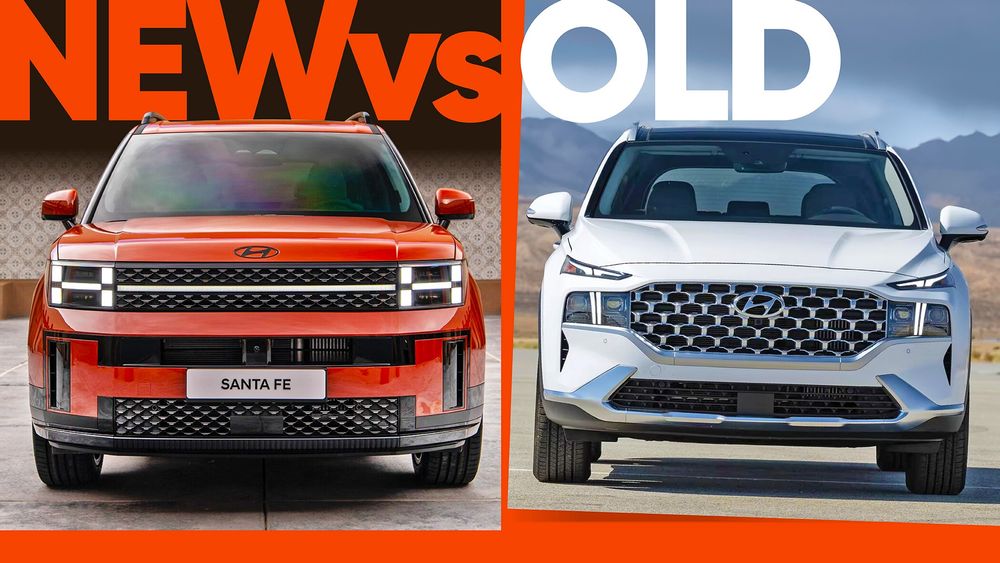
With its muscular, angular sheetmetal, it’s hard to believe we once described the Hyundai Santa Fe as having “spooky front-end styling.” While the old model continued to place near the top of our Ultimate Car Rankings in its twilight years, the Santa Fe had room for improvement. As the recipient of a dramatic redesign, the fifth generation of the Hyundai Santa Fe appears to address many of our criticisms, starting with its styling. The changes go well beyond simple cosmetics, though, and we’ve detailed the most significant differences between the old and new Hyundai Santa Fe so you can decide if it’s worth springing for the 2024 model.
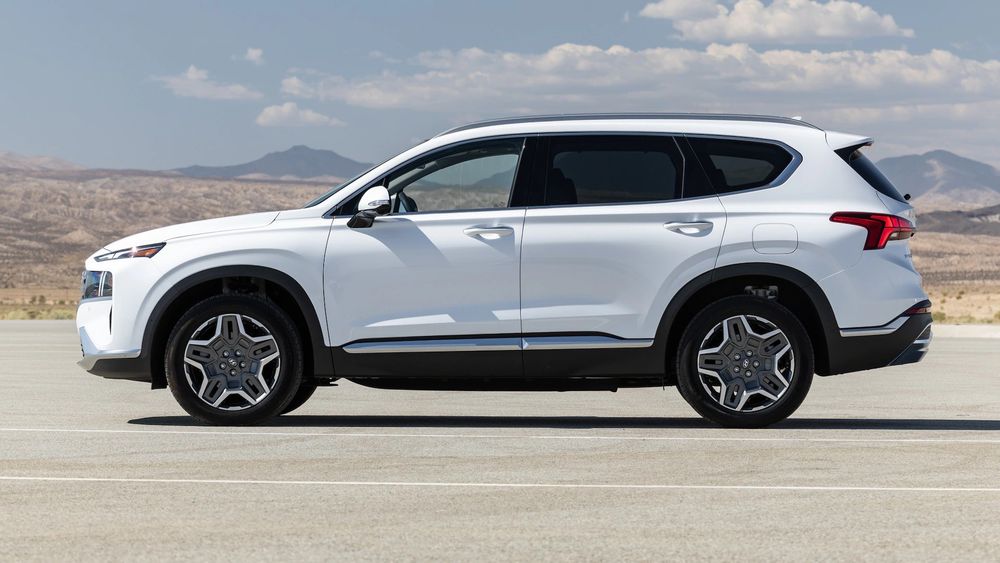
Old Hyundai Santa Fe | Side View
Although its profile is familiar now, the previous fourth-generation Santa Fe’s Euro-esque silhouette was significantly tauter and more streamlined than the rather bland third-generation SUV it replaced. Attractive wheel options endowed the discontinued Santa Fe with a bit more road presence. Plastic body cladding over the wheel arches offered some rugged appeal, although almost everything else about non-XRT Santa Fe SUVs telegraphed a preference for on-road driving. The earlier Hyundai Santa Fe’s wheelbase measured 108.9 inches, and its overall length was 188.4 inches. Height came out to 66.3–67.3 inches depending on trim.
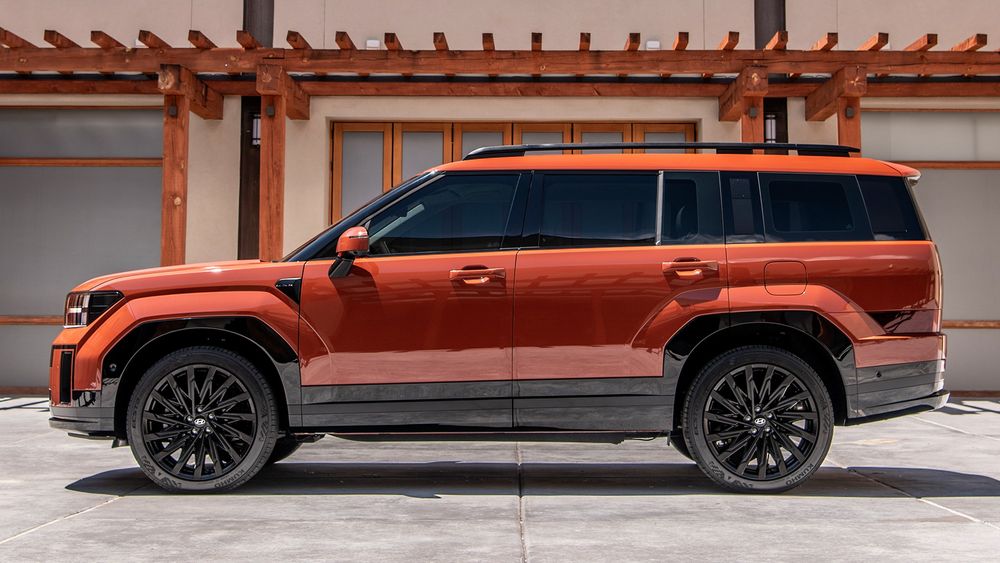
New Hyundai Santa Fe | Side View
Hyundai went for a more rugged look for the fifth-generation 2024 Hyundai Santa Fe. Prominent wheel arches complement its blocky body. Gloss black pillars grant a floating roof aesthetic that stretches from the front to the rear of the SUV. Rolling on 18-, 20-, or 21-inch multispoke wheels, the fifth-generation Santa Fe has the curb appeal of a concept car. Unlike the previous XRT model, the off-road-ready version of the new Santa Fe rolls on all-terrain tires and benefits from an extra 1.3 inches of ground clearance over the standard models’ 7.0 inches. The 2024 Hyundai Santa Fe’s wheelbase has grown to 110.8 inches, and its length has stretched to 190.2 inches. New models are taller, too, standing at 67.7–69.7 inches depending on trim.
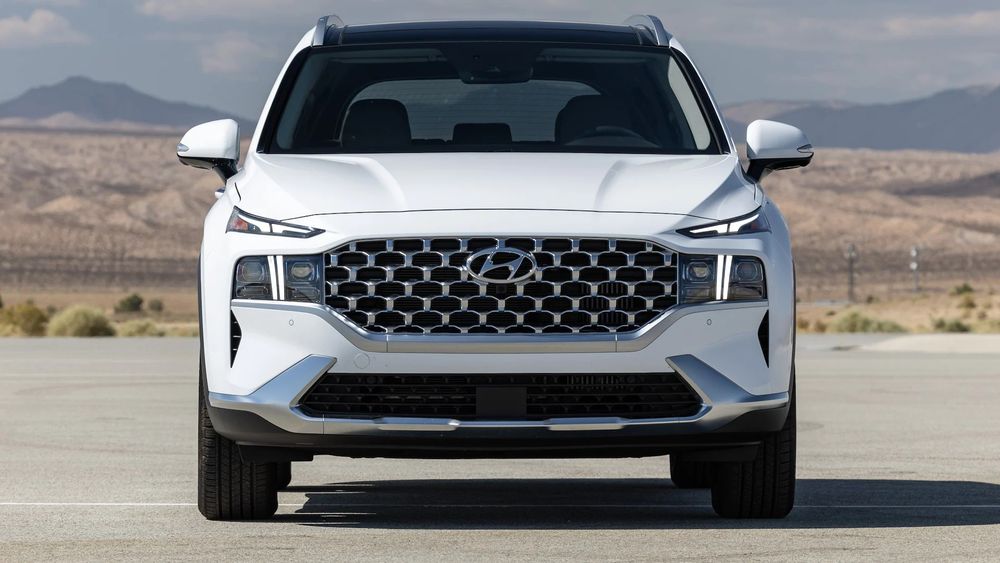
Old Hyundai Santa Fe | Front View
We found it difficult to look past the fourth-generation Hyundai Santa Fe’s toothy grille. The wide-mouthed fascia incorporated the lower headlights in the grille’s frame, a look that could hardly be described as elegant. Squinty, pointy upper headlights added yet another busy element to the SUV’s front end. At night, the sets of headlights combine to make a “T” shape when illuminated. The lower front bumper featured more kinks and angles, not only emphasizing the outgoing Santa Fe’s width, but also adding a dash of sportiness to its visage. Its width measured 74.8 inches, and the front track was 64.8 inches.
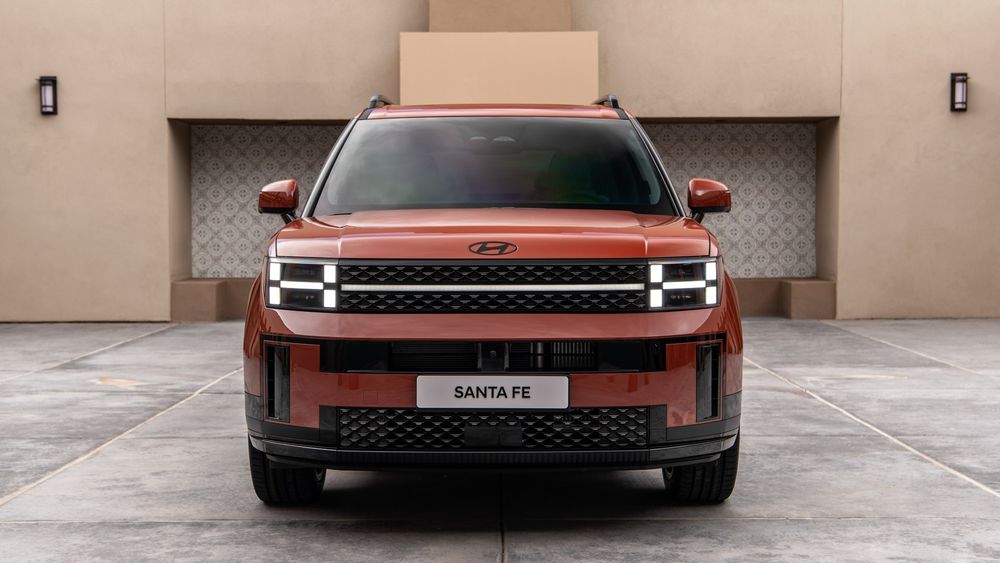
New Hyundai Santa Fe | Front View
The letter H serves as the predominant motif for the 2024 Hyundai Santa Fe’s front fascia. Even though the new SUV rides on a unibody platform, its squared-off nose recalls old-school body-on-frame utes. The split headlight design is gone, replaced by new H-pattern LED headlamps that can greet the driver with a walkup animation. The H shape is duplicated across the entirety of the Santa Fe’s lower bumper, split by the license plate mounting point. Those who aren’t required by their state to use a front license plate can enjoy a body-color H that dominates their Santa Fe’s front end. Hyundai claims a slippery drag coefficient of just 0.29, a figure that defies the Santa Fe’s blocky form. The 2024 Hyundai Santa Fe didn’t get any wider than the previous model, so its width stays the same at 74.8 inches. The front track also carries over at 64.8 inches.
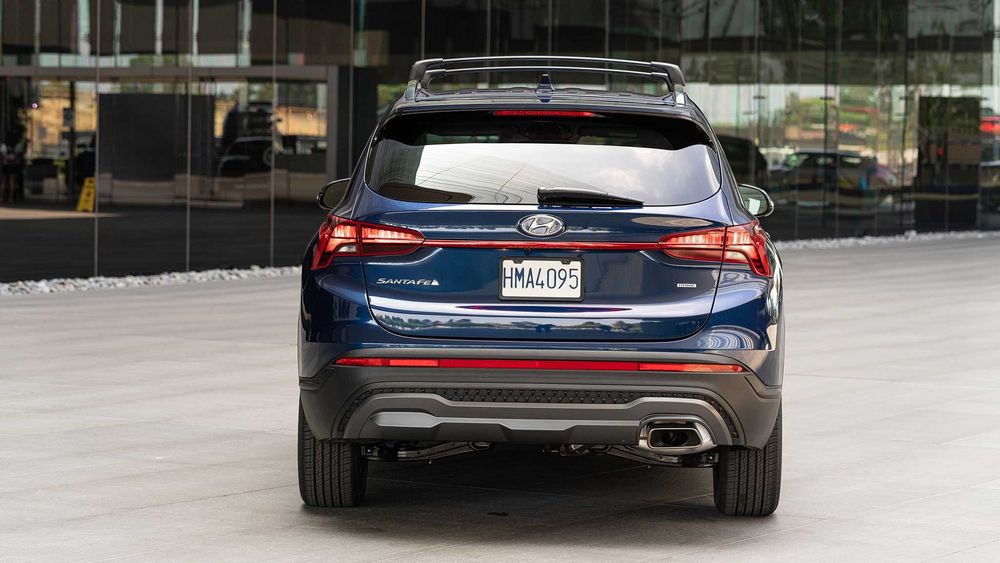
Old Hyundai Santa Fe | Rear View
Although the front end of the outgoing Hyundai Santa Fe was severely overstyled, the rear end had a more conventional design. A stylish horizontal lightbar connected the taillights, and a singular sculpted exhaust outlet resided under the rear bumper on the right side. The fourth-generation Santa Fe’s rear track was wider than the front at 65.2 inches.
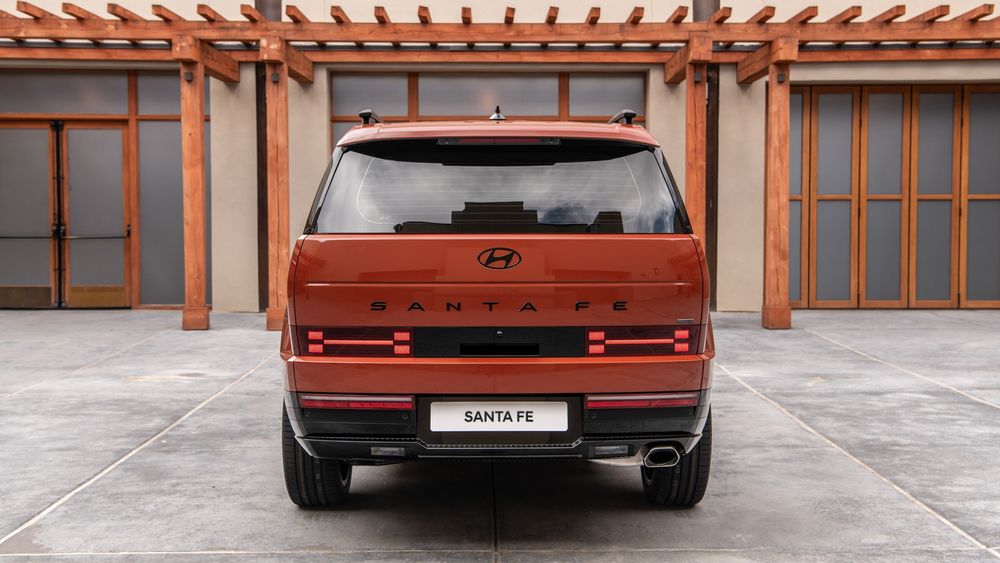
New Hyundai Santa Fe | Rear View
Horizontal lines contribute to the 2024 Hyundai Santa Fe’s wide appearance, a cohesive finish to the SUV’s boxy exterior. The H-shaped lighting elements continue here, with both taillights making use of this motif. Where some manufacturers have used plastic cladding to get away with using less paint, Hyundai covers nearly the entire rear fascia of the Santa Fe in the body color’s hue. The exhaust tip, while still finished with a sculpted look, is deemphasized compared to that of the prior model. Although the new Santa Fe has an imposing stance, its rear track is 0.1 inch narrower than its predecessor, at 65.1 inches.
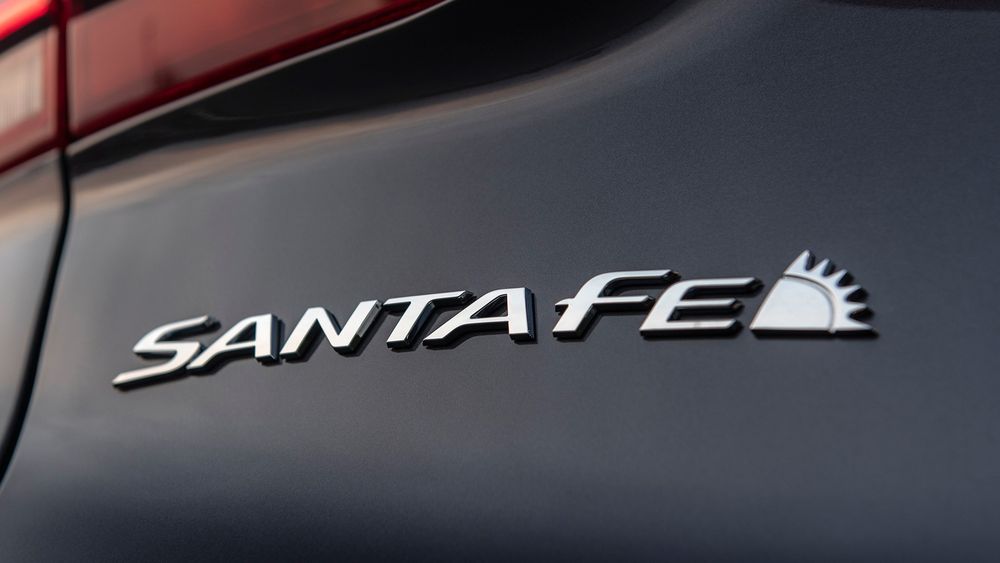
Old Hyundai Santa Fe | Badges
Older versions of the Hyundai Santa Fe used sculpted chrome badges with a three-dimensional look. The Santa Fe’s name logo featured a quarter of a sun as part of its signature look, which had been in use since the SUV was first introduced for the 2001 model year. Models that received an HTRAC badge were equipped with Hyundai’s intelligent all-wheel-drive system. Hybrid models wore a badge that described them as such while the Santa Fe PHEV received a “plug-in” badge.
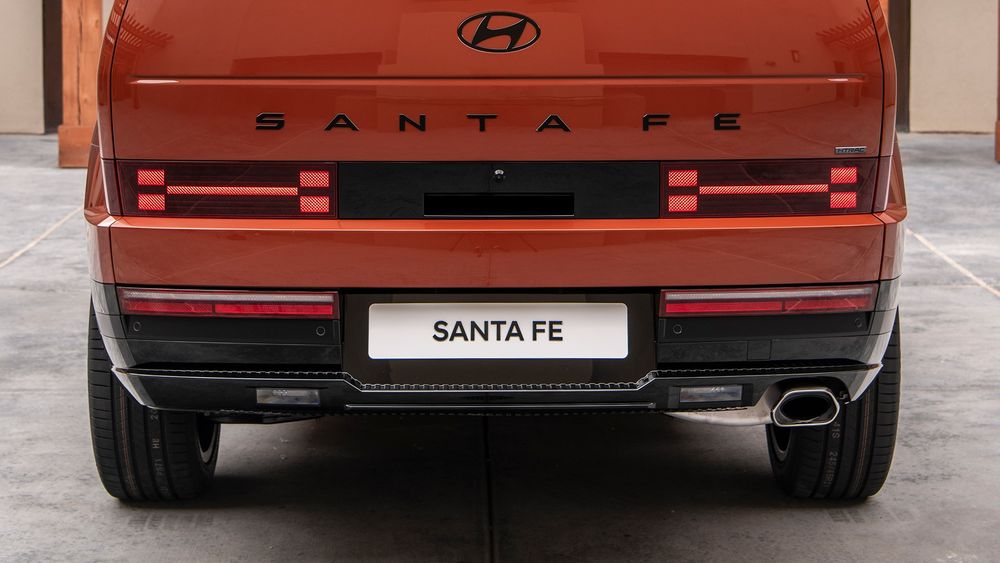
New Hyundai Santa Fe | Badges
Hyundai modernized the 2024 Santa Fe’s badging following the rest of its design. The badging appears either in anodized silver or anodized black, depending on trim. Rather than displaying the Santa Fe logo in a small script on the bottom left of the rear hatch, the SUV’s name now spans the very center of the tailgate. Hyundai’s quarter-sun logo has also been discontinued for the fifth-generation model. A small HTRAC badge appears on all-wheel-drive variants on the right side of the rear, just above the taillight. Hyundai hasn’t shown off the hybrid model just yet, so it’s unclear whether that version will receive its own badge. The XRT model wears a stylized badge calling out the trim name.
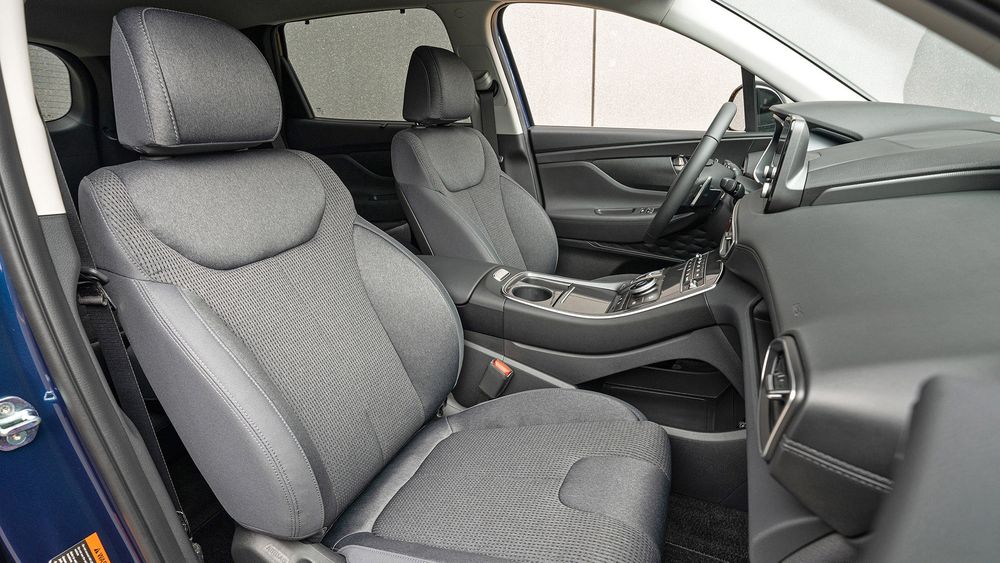
Old Hyundai Santa Fe | Interior
We praised the old Hyundai Santa Fe’s interior for its upscale design and materials. Still, the button-heavy center console aged poorly as the automaker shifted to interior layouts featuring more touch-capacitive controls. We noted that the Santa Fe’s front and second rows offered generous legroom for passengers, and that the cargo area was on par with but not better than its rivals. Every model came equipped with dual USB ports in the front and second rows, and upper trims came with wireless charging. Other upscale features included a 12-speaker Harman Kardon audio system, a 360-degree camera, and phone-as-key functionality—Smart Park was available, too.
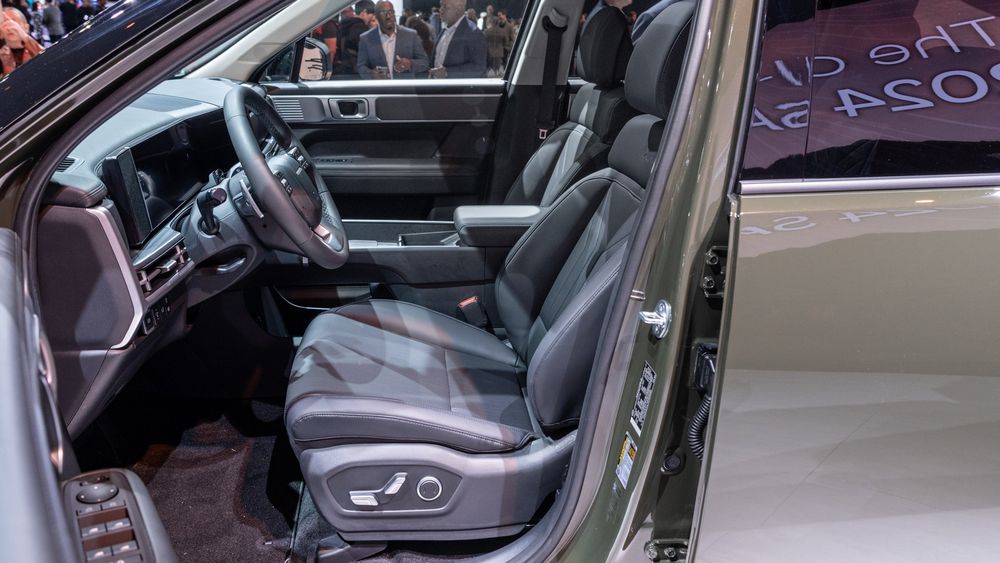
New Hyundai Santa Fe | Interior
Hyundai employed lots of horizontal lines when designing the interior of the 2024 Santa Fe. The cabin is more spacious than the prior model and even offers seating for a third row of passengers. Hyundai says overall cargo space has grown, expanding beyond the outgoing SUV’s 72.0 cubic feet. We’re impressed by the new Santa Fe’s materials; the available two-tone green and off-white interior looks genuinely upscale. However, the monochromatic black option is drab. The Santa Fe’s shifter has moved to the steering column for 2024, freeing up space for a second wireless phone charger. A UV-C sanitizer is available inside the glovebox. The center console features two large cupholders capable of accommodating oversized beverages. While the dual-pane roof lets in lots of light, we wish that the 2024 Santa Fe was offered with a true panoramic glass top.
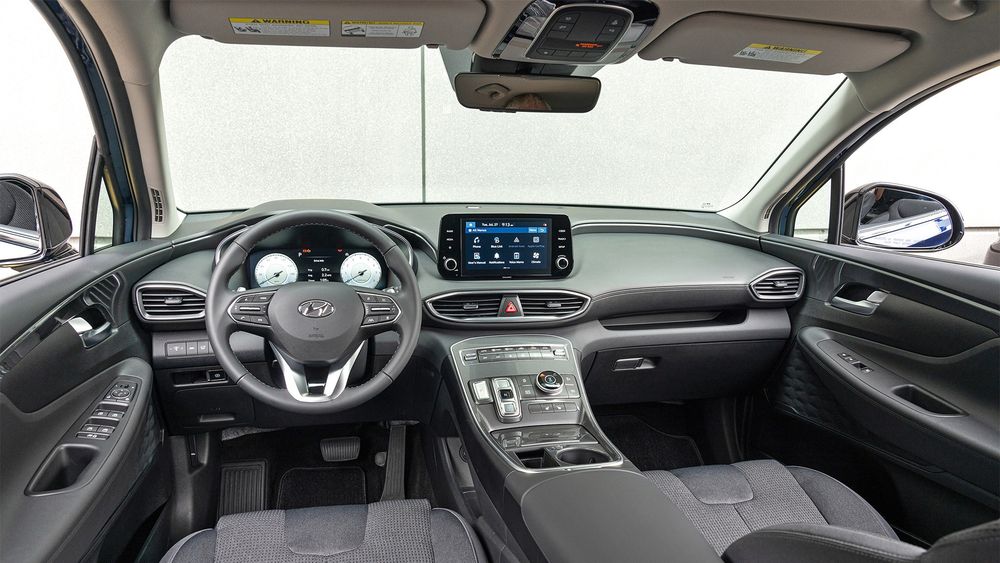
Old Hyundai Santa Fe | Dashboard
Standard equipment for the fourth-generation Santa Fe included an 8.0-inch infotainment touchscreen, Apple CarPlay, and Android Auto. Higher trim levels came equipped with a 10.3-inch touchscreen paired with a 12.3-inch digital instrument cluster. Wireless CarPlay and Android Auto accompanied the larger infotainment display. The old Santa Fe’s dash was relatively conventional in its appearance, although we appreciated the large tray found above the glove box.
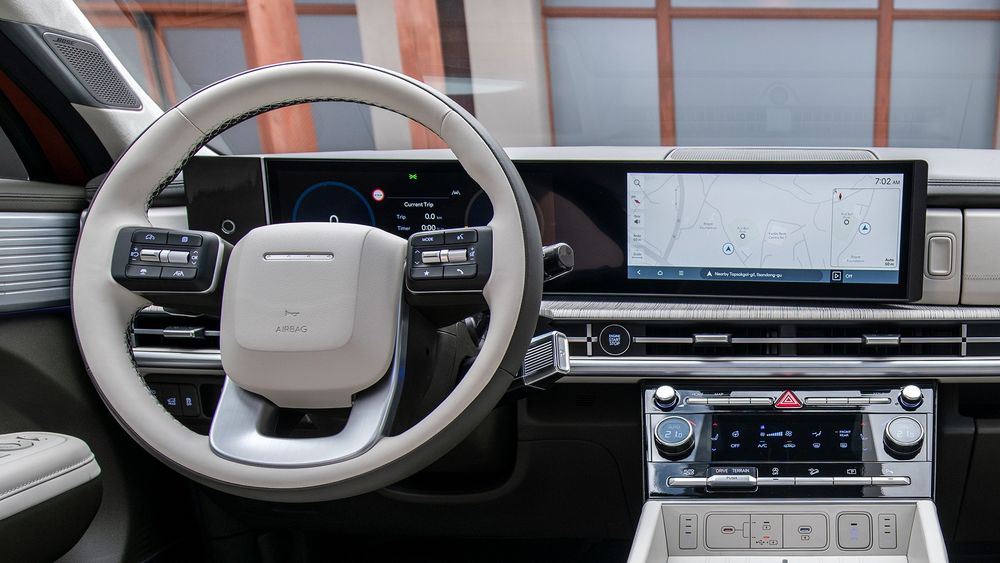
New Hyundai Santa Fe | Dashboard
Reimagined to keep up with contemporary rivals, the 2024 Hyundai Santa Fe features dual 12.3-inch displays for the infotainment touchscreen and digital instrument cluster on all models. Wireless Android Auto and Apple CarPlay are equipped on all examples of the midsize SUV. Rather than forsaking buttons and knobs entirely, the Santa Fe’s center stack uses a variety of controls for media and HVAC features. The Santa Fe’s steering wheel features the Morse code version of its logo, an H represented by four dots. The spokes feature a new button and scroll wheel scheme that’s yet to be used on other Hyundai products. Instead of a storage tray, the new Santa Fe receives an upper glove box for more discreet storage.
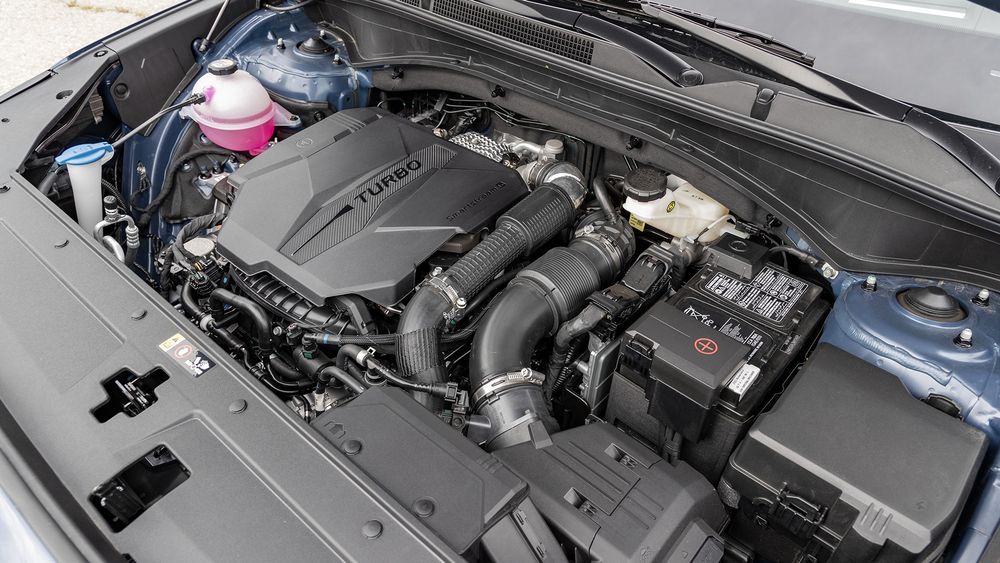
Old Hyundai Santa Fe | Powertrains
Most gas-only versions of the fourth-generation Hyundai Santa Fe came equipped with a 2.5-liter I-4 engine developing 191 hp and 181 lb-ft of torque. This engine was paired with an eight-speed automatic transmission. Front-wheel drive was standard, and all-wheel drive was available. Acceleration to 60 mph came in about 9.0 seconds. Fuel economy was rated at 25/28 mpg city/highway with FWD, and 22/25 mpg with AWD.
The step-up Limited and Calligraphy trims equipped a 2.5-liter turbocharged I-4 developing 281 hp and 311 lb-ft of torque, plus an eight-speed dual-clutch automatic transmission. Front-wheel drive was standard, and all-wheel drive was available. Turbo versions of the Santa Fe were downright quick, with all-wheel-drive models accelerating from 0 to 60 mph in just 6.2 seconds. Fuel economy was slightly worse at 22/28 mpg with FWD and 21/28 mpg with AWD.
Hybrid models received a 1.6-liter turbocharged I-4 and an electric motor producing 226 total hp. Every Santa Fe Hybrid received a six-speed automatic transmission and AWD. These models were quicker than the naturally aspirated versions of Hyundai’s SUV but slower than the turbo gasoline-only variant. We tested the Santa Fe Hybrid at an 8.2-second 0–60-mph sprint. EPA ratings for the extra frugal Santa Fe Hybrid Blue were 33/30 mpg, and all other versions returned 36/31 mpg.
The Hyundai Santa Fe Plug-in Hybrid received a larger 13.8-kWh battery pack, raising output to 261 hp and 258 lb-ft of torque. Reaching 60 mph from a stop took 7.0 seconds, making it the second quickest version of the old Santa Fe. The EPA rated the Santa Fe equipped with the Plug-in Hybrid at 76 mpg-e and 31 miles of electric-only driving range.
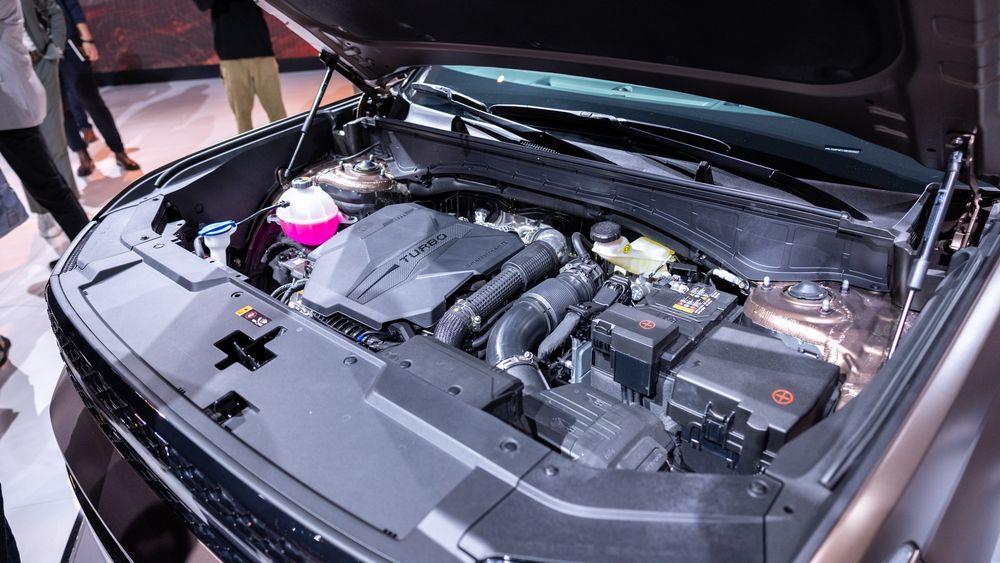
New Hyundai Santa Fe | Powertrains
Hyundai has chopped the number of available powertrains in half for the 2024 Santa Fe. We expect most new Santa Fe SUVs seen on the road to make use of a 2.5-liter turbocharged inline-four developing 277 hp and 311 lb-ft of torque. An eight-speed dual-clutch automatic transmission comes standard on all Santa Fe models, regardless of whether the standard FWD layout or the available AWD setup is equipped. The EPA has rated the 2024 Santa Fe at 20/29 mpg city/highway with FWD and 20/28 mpg with AWD. XRT models receive functional off-road equipment this time around, which lowers fuel economy to 19/26 mpg.
The 2024 Hyundai Santa Fe Hybrid comes equipped with a 1.6-liter turbocharged four-cylinder engine and an electric motor developing 232 hp and 271 lb-ft of torque. AWD comes standard. We don’t expect fuel economy to improve because the new Santa Fe is up to 600 pounds heavier than its predecessor.
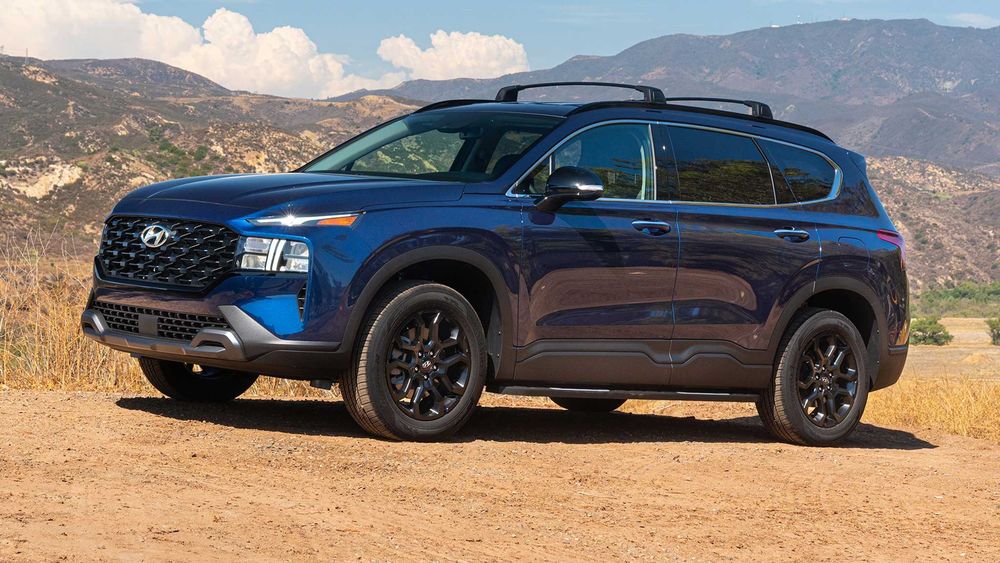
Old Hyundai Santa Fe | XRT Trim
The outgoing Hyundai Santa Fe’s XRT trim wasn’t anything of note. Offered with cosmetic-only touches, the Santa Fe XRT could be had with FWD or AWD. Every Santa Fe XRT came equipped with trim-specific black-painted 18-inch wheels, extra black plastic body cladding, side steps, front and rear skidplates, black-painted door mirror caps and roof rails, and a matte-black grille. All-season tires were equipped as standard.
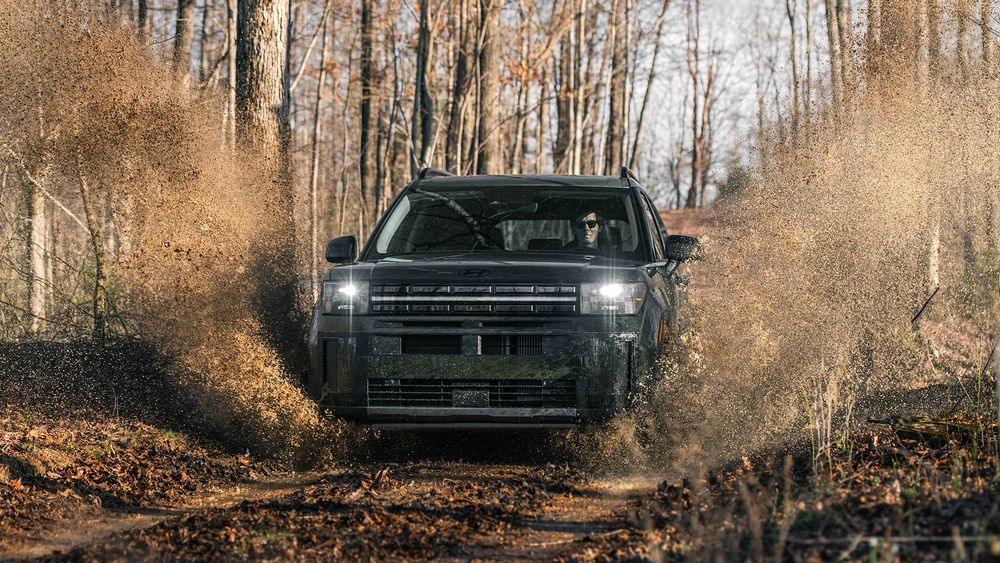
New Hyundai Santa Fe | XRT Trim
Hyundai takes the 2024 Santa Fe XRT further for the fifth-generation model. All-wheel drive is standard, and ground clearance improves by 1.3 inches. Every XRT model rides on 18-inch dark alloy wheels and benefits from all-terrain tires. The differences stop there, but in our First Drive review, we noted the additional equipment lent impressive off-road performance to the 2024 Santa Fe XRT.
Billy Rehbock's passion for cars started with his dad's Volkswagen Jetta GLX, his mom's Cabriolet, and his own Hot Wheels collection. A USC graduate with a Master of Science in journalism, he's an associate editor for the MotorTrend Buyer's Guide and covers everything from sports cars to SUVs.
Read More